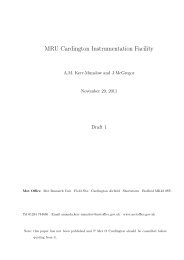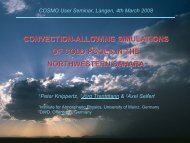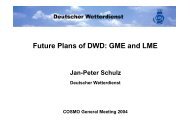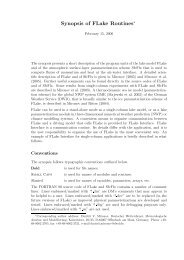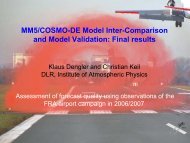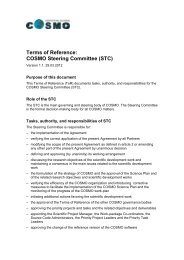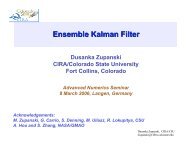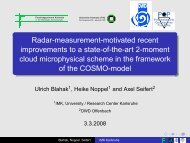Generalizing cloud overlap treatment to include solar ... - Cosmo
Generalizing cloud overlap treatment to include solar ... - Cosmo
Generalizing cloud overlap treatment to include solar ... - Cosmo
- No tags were found...
Create successful ePaper yourself
Turn your PDF publications into a flip-book with our unique Google optimized e-Paper software.
Statement of the Problem Proposed new <strong>overlap</strong> scheme Scheme validation in a 1D framework Validation in 3D simulation Conclusions<strong>Generalizing</strong> <strong>cloud</strong> <strong>overlap</strong> <strong>treatment</strong> <strong>to</strong><strong>include</strong> <strong>solar</strong> zenith angle effects on <strong>cloud</strong>geometryFrancesca Di Giuseppe and Adrian M. TompkinsICTP, Trieste Italy and ARPA-SIM, Bologna,ITCOSMO, Cracow 2008All material available at:http : //users.ictp.it/ <strong>to</strong>mpkins/Tompkins A. M. and F. Di Giuseppe. <strong>Generalizing</strong> Cloud Overlap Treatment <strong>to</strong> Include Solar Zenith Angle Effects on Cloud Geometry.Journal of the Atmospheric Sciences. 64, 2116 − 2125. (2007)
Statement of the Problem Proposed new <strong>overlap</strong> scheme Scheme validation in a 1D framework Validation in 3D simulation ConclusionsOutlineStatement of the ProblemProposed new <strong>overlap</strong> schemeScheme validation in a 1D frameworkDataResultsValidation in 3D simulationECMWFCOSMOConclusions
Statement of the Problem Proposed new <strong>overlap</strong> scheme Scheme validation in a 1D framework Validation in 3D simulation ConclusionsSW Radiative Transfer in <strong>cloud</strong>sProblem: modelling the pho<strong>to</strong>n interaction with a 3D <strong>cloud</strong> field.Several “geometrical” aspects need <strong>to</strong> be considered:1spatial arrangements of <strong>cloud</strong>s element2vertical <strong>overlap</strong>3sun position
Statement of the Problem Proposed new <strong>overlap</strong> scheme Scheme validation in a 1D framework Validation in 3D simulation ConclusionsRepresentation of <strong>cloud</strong>s in GCMGCMs represent the previous two scenes in the same way regardlessof the sun positionAt each vertical layer the <strong>cloud</strong> is represented in terms of a <strong>cloud</strong> fraction.The vertical arrangement is established following <strong>overlap</strong> rules. The sunposition is only accounted for by rescaling the pho<strong>to</strong>n path length.2 effects are neglected: the horizontal transport of pho<strong>to</strong>ns and the effectiveincrease of <strong>cloud</strong> cover at lower sun angles.% bias correction of PP by TICAcompared <strong>to</strong> benchmark 3D MCcalculation: sun low=error fromgeometry, sun high error from 3DscatteringDi Giuseppe, F., and A.M. Tompkins, 2005: Impact of Cloud Cover on SolarRadiative Biases in Deep Convective Regimes. , 62,1989 − 2000
Statement of the Problem Proposed new <strong>overlap</strong> scheme Scheme validation in a 1D framework Validation in 3D simulation ConclusionsOverlap rules1 maximum <strong>overlap</strong>: C MAXi,j2 random <strong>overlap</strong>: C RANi,j= max{C i , C j } i.e. min Cloud Cover (CC)= C i + C j − C i ∗ C j3 max-ran <strong>overlap</strong>: adjacent layer=max <strong>overlap</strong>, non-adjacent layer=ran
Statement of the Problem Proposed new <strong>overlap</strong> scheme Scheme validation in a 1D framework Validation in 3D simulation ConclusionsHogan approachEXP-RAN <strong>overlap</strong>: Using as proxy RADAR data (Hogan and Illingworth(2000)) proposed a decorrelation length L 0 (approx 2 km) for continuous<strong>cloud</strong>s.C EXP−RANi,j= αC MAX−RANi,jwhere: α = exp(− ∆zL 0)+ (1 − α)C RANi,j
Statement of the Problem Proposed new <strong>overlap</strong> scheme Scheme validation in a 1D framework Validation in 3D simulation ConclusionsParameterising <strong>solar</strong> zenith angle effectsThe new parametrisation represents the <strong>solar</strong> zenith SZA (θ 0 ) effect onapparent <strong>cloud</strong> geometry by extending the schemes EXP-RAN of Hogan, sothat:L = K (θ 0 )L 0The new scheme is called EXP-SZA-RAN.Assuming L 0 the decorrelation length-scale for the sun overhead case. Weneed a parametrisation for K (θ 0 )
Statement of the Problem Proposed new <strong>overlap</strong> scheme Scheme validation in a 1D framework Validation in 3D simulation ConclusionsDATARadar retrievals from the CloudNet EU project which provided almostcontinuous observations between the April <strong>to</strong> November 2003 at Chilbol<strong>to</strong>n,England and between March 2003 <strong>to</strong> September 2004 at Palaiseau, Franceare used.Radar classification field from typical day (27/04/2003) of the Chilbol<strong>to</strong>n radar retrieval. These scenes are split in<strong>to</strong> 2.25 hour segments,which are equivalent <strong>to</strong> an approximate dimension of 40km assuming a uniform horizontal advection velocity of 5ms −1
Statement of the Problem Proposed new <strong>overlap</strong> scheme Scheme validation in a 1D framework Validation in 3D simulation ConclusionsMethodologyMissing data points corrected if possible, or scenediscardedOnly scenes with 5% < CloudCover < 80% areconsideredHorizontal sub-<strong>cloud</strong> inhomogeneities are removed(plane parallel)Scenes are shifted using the SZA for the TICAbenchmark simulation.L 0 chosen from data <strong>to</strong> given correct <strong>to</strong>tal <strong>cloud</strong>cover when sun overhead (L 0 =4.0km)Radiative calculations made with scheme ofMorcrette (1991) as used in ECMWF operationalmodel in 2005.
Statement of the Problem Proposed new <strong>overlap</strong> scheme Scheme validation in a 1D framework Validation in 3D simulation ConclusionsTotal Cloud Cover (TCC)TCC vs SZA averaged for over 150 <strong>cloud</strong> scenes at Chilbol<strong>to</strong>n site. The trueTICA TCC reference is shown by the dotted line on the left.1 Random <strong>overlap</strong> is good approximation for low sun angles2 The linear parametrization fits the <strong>cloud</strong> cover the best
Statement of the Problem Proposed new <strong>overlap</strong> scheme Scheme validation in a 1D framework Validation in 3D simulation ConclusionsImpact on radiative biasesThe new scheme greatly reduces the net bias (wrt TICA) integratedover all sun angles compared <strong>to</strong> the standard <strong>overlap</strong> schemes
Statement of the Problem Proposed new <strong>overlap</strong> scheme Scheme validation in a 1D framework Validation in 3D simulation ConclusionsECMWF’s implementation3D calculations repeated with RapidRadiative Transfer Model (RRTM) radiationcode (Mlawer and Clough 1997) which isnow operational at ECMWF (Scheme choicedid not affect the conclusions)Panels show effect on TOA SW fluxes in 3hour forecast of changing progressivelyMAX-RAN − > EXP-RAN − >EXP-SZA-RAN (new) − > RANnew scheme has half impact of EXP-RAN(depends on L 0 )dynamical feedback limited in year-longintegrations (with imposed SSTs)
Statement of the Problem Proposed new <strong>overlap</strong> scheme Scheme validation in a 1D framework Validation in 3D simulation ConclusionsCOSMO’s implementationPreliminary results from the COSMO implementation.Panel shows effect on TOA SW fluxes in 3 hourforecast of changing EXP-RAN − > EXP-SZA-RAN (new)new scheme has major impact where sunlower above the horizon ( thus it depends on latitude)<strong>to</strong> put in<strong>to</strong> contest:in March at 12:00 UTCSZA = 45deg at 35N latitudeSZA = 60deg at 50N latitudeLocally, effects as large as 40 Wm-2.
Statement of the Problem Proposed new <strong>overlap</strong> scheme Scheme validation in a 1D framework Validation in 3D simulation ConclusionsConclusionsHogan generalised the MAX-RAN <strong>to</strong> the EXP-RAN <strong>overlap</strong> <strong>to</strong>account for shearing of continuous <strong>cloud</strong>sWe have further generalised EXP-RAN <strong>to</strong> the EXP-SZA-RAN <strong>to</strong>account for the sun positionThe new scheme improves the <strong>to</strong>tal <strong>cloud</strong> cover errors asfunction of sun angleThe scheme improves radiative flux/heating rate calculationrelative <strong>to</strong> benchmark TICA calculationsParametrisation extremely simple <strong>to</strong> implementThe dynamical impact in 3D model was limited - but this is alsothe case changing from MAX-RAN <strong>to</strong> Hogan’s EXP-RAN. Largerin coupled model?




